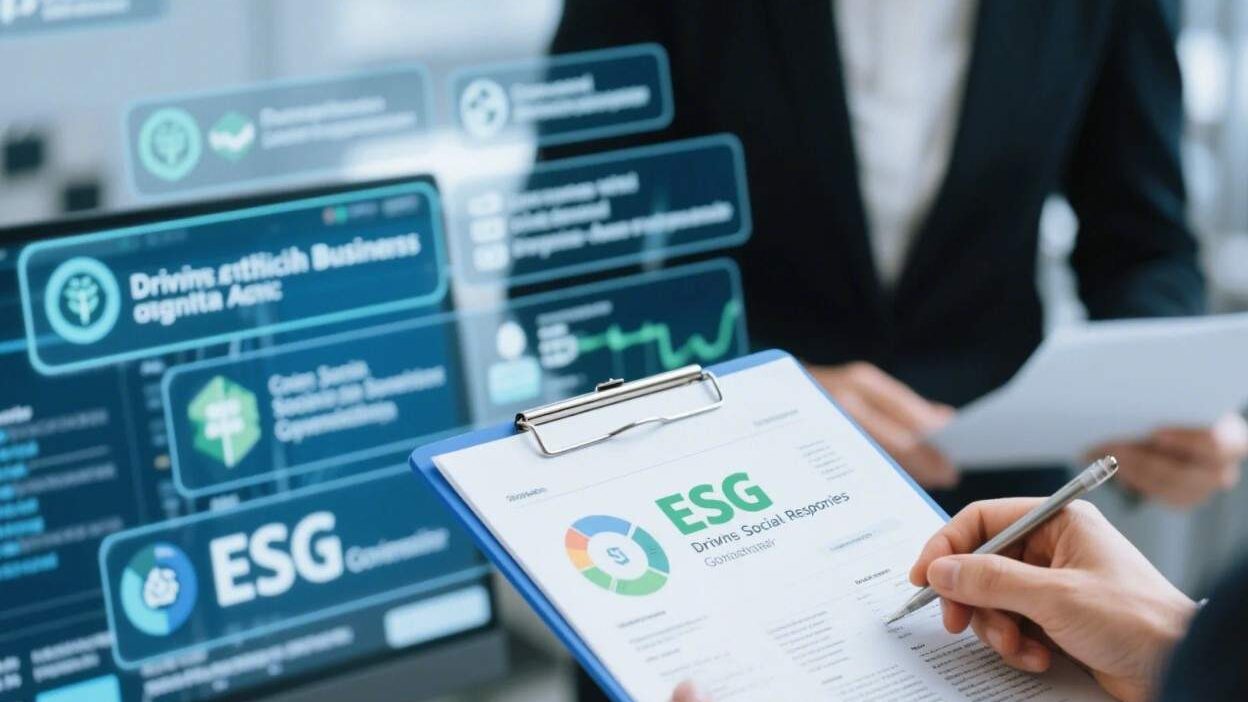Driving Ethical Business in the Digital Age
ESG Compliance—A Non-Negotiable in a Conscious World
In an era where consumers, investors, and regulators demand accountability, Corporate Social Responsibility (CSR) has evolved into a strategic imperative. Environmental, Social, and Governance (ESG) compliance—measuring a company’s impact on the planet, people, and operations—has become a cornerstone of sustainable business practices. Yet, traditional ESG auditing is often slow, manual, and prone to human error, struggling to keep pace with the complexity of modern supply chains, global regulations, and stakeholder expectations.
Enter AI auditing for ESG compliance: a revolutionary approach that leverages machine learning, natural language processing (NLP), and predictive analytics to transform how companies track, verify, and report their ESG performance. By automating data collection, flagging risks in real time, and generating actionable insights, AI is not just streamlining audits—it’s redefining what it means to be a responsible business. This report explores how AI is reshaping ESG compliance, its benefits, challenges, and the future of ethical business in the digital age.
What Is AI Auditing for ESG Compliance?
AI auditing for ESG compliance refers to the use of artificial intelligence tools to automate, enhance, and validate a company’s ESG reporting and adherence to regulatory standards. Unlike traditional audits—reliant on manual data entry, spreadsheets, and periodic checks—AI-driven systems:
- Aggregate Data: Pull ESG-related information from disparate sources (e.g., supply chain databases, employee surveys, IoT sensors).
- Analyze Trends: Use machine learning to identify patterns, anomalies, or risks (e.g., rising carbon emissions, labor violations).
- Automate Reporting: Generate real-time, standardized ESG reports that align with global frameworks (e.g., GRI, SASB, TCFD).
- Predict Risks: Forecast potential ESG issues (e.g., supply chain disruptions due to climate events) before they escalate.
This approach transforms ESG compliance from a reactive, box-ticking exercise into a proactive, data-driven strategy—one that aligns with stakeholder demands for transparency and accountability.
How AI Auditing Works: Key Components and Technologies
AI auditing for ESG compliance is a multi-layered process, powered by cutting-edge technologies:
1. Data Aggregation and Analysis
ESG data is often fragmented—scattered across invoices, contracts, social media, and IoT devices. AI tools like NLP engines and data crawlers aggregate this data, cleaning and structuring it into actionable insights. For example:
- Supply Chain Data: AI analyzes shipping manifests, supplier audits, and carbon tracking tools to map a company’s environmental footprint.
- Social Data: Sentiment analysis on employee reviews, community feedback, and media coverage highlights social risks (e.g., workplace discrimination).
- Governance Data: AI scans board meeting minutes, executive compensation reports, and regulatory filings to assess governance practices.
2. Real-Time Monitoring and Alerts
Traditional audits are periodic (e.g., quarterly or annual), leaving gaps for undetected issues. AI enables continuous monitoring:
- IoT Integration: Sensors in factories, warehouses, or logistics fleets feed real-time data (e.g., energy usage, waste output) into AI systems, flagging deviations from sustainability targets.
- Anomaly Detection: Machine learning models identify unusual patterns—like a sudden spike in water usage at a manufacturing plant—prompting immediate investigation.
3. Predictive Risk Assessment
AI doesn’t just react to problems—it predicts them. By analyzing historical data and external factors (e.g., climate models, regulatory changes), AI forecasts ESG risks:
- Climate Risks: A retail company might use AI to predict supply chain disruptions due to extreme weather, enabling proactive shifts to resilient suppliers.
- Social Risks: An AI tool could flag potential labor disputes by analyzing employee turnover rates, wage gaps, or local union activity.
4. Automated Reporting and Compliance
Generating ESG reports manually is time-consuming and error-prone. AI automates this process by:
- Mapping to Standards: Tools like Sustain.Life or ESG.ai align data with global frameworks (e.g., TCFD for climate disclosures), ensuring reports meet investor and regulator expectations.
- Dynamic Dashboards: Interactive platforms (e.g., Microsoft’s Sustainability Manager) visualize ESG metrics in real time, allowing stakeholders to track progress toward goals (e.g., net-zero emissions by 2030).
Why AI Auditing for ESG Compliance Matters
The benefits of AI-driven ESG auditing are transformative, addressing critical gaps in traditional practices:
1. Enhanced Accuracy and Speed
Manual audits are slow (taking weeks or months) and prone to human error. AI processes data in real time, reducing reporting cycles to days or even hours. For example, Amazon uses AI to audit its supply chain for deforestation, cutting report generation time from 30 days to 48 hours.
2. Proactive Risk Management
By identifying risks early, AI helps companies avoid costly crises. A 2023 study by McKinsey found that AI-driven ESG audits reduced supply chain disruption risks by 40% for manufacturing firms.
3. Cost Efficiency
AI eliminates the need for large audit teams and manual data entry. Deloitte estimates that AI can reduce ESG auditing costs by 30–50% for mid-sized companies.
4. Improved Transparency and Trust
Stakeholders (investors, customers, regulators) demand proof of ESG claims. AI-generated reports, backed by immutable data trails, build credibility. For instance, Patagonia uses AI to verify its supply chain sustainability, enhancing trust among eco-conscious consumers.
5. Scalability
As companies grow, so do their ESG complexities. AI scales effortlessly, handling vast datasets and cross-border operations without proportional increases in cost or effort.
Challenges and Considerations
While AI promises revolution, it’s not without hurdles:
1. Data Quality and Bias
AI relies on high-quality data. Incomplete, biased, or outdated data (e.g., underreporting of carbon emissions) can lead to flawed insights. Companies must invest in robust data governance—ensuring data is accurate, diverse, and audited.
2. Regulatory and Ethical Hurdles
Regulations around AI and ESG are evolving. The EU’s Corporate Sustainability Reporting Directive (CSRD) and the U.S. SEC’s climate disclosure rules require transparency, but AI’s use in auditing must comply with privacy laws (e.g., GDPR) and avoid algorithmic bias.
3. Human-AI Collaboration
AI is a tool, not a replacement for human judgment. Auditors must validate AI findings, interpret context (e.g., cultural nuances in social data), and ensure ethical use of technology.
4. Technical Complexity
Implementing AI requires expertise in machine learning, data engineering, and ESG frameworks. Small and medium-sized enterprises (SMEs) may lack resources, limiting adoption.
Real-World Examples: Companies Leading the AI ESG Audit Revolution
1. Microsoft: AI-Driven Sustainability Reporting
Microsoft uses AI to track its carbon footprint across 180 countries. Machine learning models analyze energy usage, supply chain data, and renewable energy procurement, generating real-time reports aligned with the TCFD framework. This has enabled Microsoft to reduce emissions by 30% since 2020.
2. Google: ESG Analytics with BigQuery
Google leverages its BigQuery platform to aggregate ESG data from 200+ suppliers. AI tools analyze this data to identify risks (e.g., water usage in semiconductor manufacturing) and recommend mitigations, supporting its goal of 100% renewable energy by 2030.
3. ESG.ai: Democratizing AI Auditing
ESG.ai, a startup, offers affordable AI tools for SMEs. Its platform automates ESG reporting, integrates with accounting software, and provides actionable insights—making ESG compliance accessible to smaller businesses.
4. Sustain.Life: AI for Social Impact
Sustain.Life uses NLP to analyze employee surveys and social media, flagging issues like workplace harassment or diversity gaps. This has helped companies like Unilever improve their social governance scores by 25% in two years.
The Future: AI as a Catalyst for Ethical Business
The future of AI in ESG auditing is brimming with innovation:
- Integration with IoT and Edge Computing: Sensors and edge devices will feed real-time ESG data (e.g., factory emissions, supply chain routes) directly into AI systems, enabling hyper-localized risk management.
- Blockchain for Immutable Data: Blockchain’s transparency will complement AI by securing ESG data trails, ensuring audits are tamper-proof.
- Regulatory Adoption: As governments mandate stricter ESG disclosures (e.g., the EU’s CSRD), AI will become a standard tool for compliance, driving industry-wide adoption.
AI—The Key to Ethical and Sustainable Business
AI auditing for ESG compliance is more than a technological upgrade—it’s a paradigm shift. By automating data collection, enhancing accuracy, and enabling proactive risk management, AI empowers companies to meet stakeholder demands, reduce costs, and build trust.
As the world grapples with climate change, social inequality, and regulatory complexity, AI-driven ESG auditing is not just a tool—it’s a necessity. It’s time for businesses to embrace AI, not as a substitute for ethics, but as a partner in building a more sustainable, equitable future.



